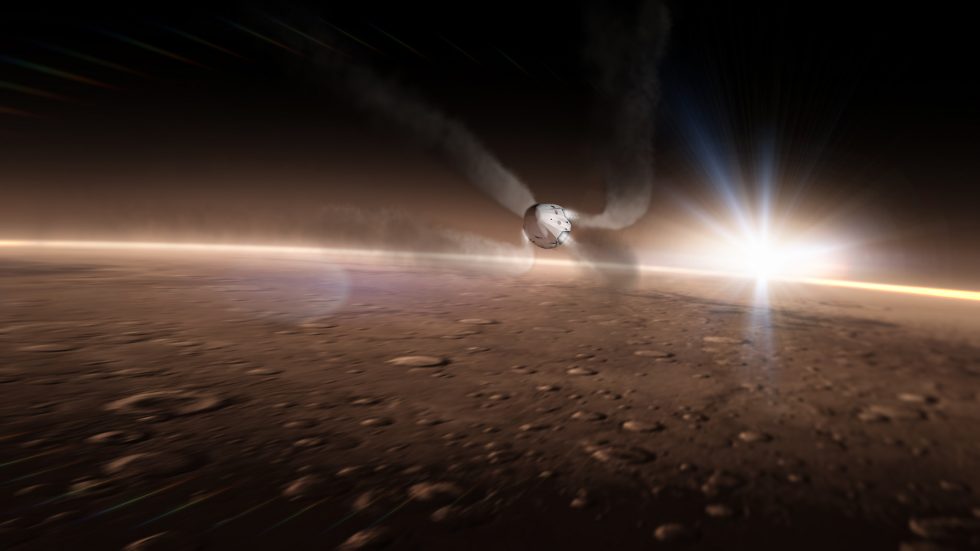
This week SpaceX announced plans to land a Dragon spacecraft on Mars by 2018. This would be a monumental achievement for NASA or any other national space agency, let alone a single company, considering the 6,000kg Dragon is nearly an order of magnitude more massive than anything previously landed on the red planet.
With the long-term goal of Mars colonization squarely in its crosshair, SpaceX has been testing key technologies needed to land on Mars for years. One of them is supersonic retro-propulsion, which Ars revealed has been tested on upgraded Falcon 9 rockets since September 2013. Supersonic retro-propulsion proved a resounding success.
But the Falcon 9 and its Merlin engines won't be going to Mars. SpaceX will use a different type of engine, the SuperDraco thruster, to propulsively land on the red planet. Here's how the landing will work: as the Dragon (dubbed Red Dragon) begins its descent to Mars at supersonic speeds, the spacecraft will fire eight of these thrusters into this onrushing atmosphere. To achieve this maneuver these engines must be capable of both high thrust, and a controllable thrust.
This gallery showcases the nearly decade-long development of the SuperDraco thrusters, critical to landing on Mars, and highlights some of their capabilities:
-
SpaceX has been working on the SuperDraco thruster for the better part of a decade. Back in June 2012, Elon Musk tweeted this photo, saying, "Just fired our SuperDraco escape rocket engine at full thrust! Needed to carry astronauts on Dragon."SpaceX
-
A propulsive hover test of Crew Dragon demonstrates how the engines operate in four pairs distributed about the spacecraft.SpaceX
-
Another view of the propulsive hover test.
-
This is a mosaic of images from a pair of SuperDraco thrusters undergoing a full test firing. Each engine is tested more than 300 times.
-
In 2013 Elon Musk tweeted this photo of a SuperDraco inconel rocket chamber, with a regenerative cooling jacket, emerging from a 3D metal printer.SpaceX
-
A year later, in 2014, the company began to reveal the full design with up close and personal photos of a SuperDraco thruster pair.SpaceX
-
Four pairs of SuperDraco engines power the Crew Dragon spacecraft's escape system.
-
About a year ago SpaceX performed a key test to ensure its "launch abort system" would work in the event of a failure. The capsule and trunk of Dragon are shown here, before the test. Four SuperDraco thrusters can be seen.SpaceX
-
This schematic shows how the pad abort test is supposed to work.SpaceX
-
During a pad abort test in 2015, the eight thrusters fired simultaneously, quickly reaching a maximum thrust, to lift Dragon off the pad.SpaceX
-
After half a second of vertical flight, the Dragon pitched toward the ocean and continued its controlled burn. The Dragon traveled from 0-100 mph in 1.2 seconds, reaching a max velocity of 345mph.
-
Shortly after, the trunk was jettisoned and the spacecraft began a slow rotation with its heat shield pointed toward the ground.
-
During the pad abort test the vehicle landed with a parachute, but SpaceX expects to eventually land astronauts on Earth using the propulsive power of the SuperDraco engines.SpaceX
-
Elon Musk first unveiled the Dragon 2 about two years ago, saying this was a "modern, 21st century spacecraft" that could land anywhere thanks to its SuperDraco thrusters.SpaceX
-
Now SpaceX has revealed that its Dragon may not only land on Earth, but Mars as well, as early as 2018.SpaceX
SpaceX has been developing SuperDraco thrusters as part of the Dragon 2 spacecraft, which is the crewed version of the original Dragon. Testing of the SuperDracos began in early 2012 using various thrust cycles on a test stand at SpaceX's rocket development facility in McGregor, Texas.
Nominally SpaceX used funds from NASA's commercial crew program to develop the thrusters for a launch abort system, which in case of an emergency during a launch allows the crew capsule to quickly escape from the rocket. SpaceX successfully tested this system in May 2015 at the company's Space Launch Complex 40 in Cape Canaveral, Florida.
While protecting the crew capsule may be the primary purpose of the SuperDraco thrusters, SpaceX also intends to use them to land "anywhere" on Earth. Instead of relying on a system of parachutes, a craft equipped with SuperDracos will have the flexibility of a helicopter. This is how the company plans to use SuperDraco thrusters to land Red Dragon propulsively on Mars.
Most of what we know about the SuperDraco's technical specifications comes from a document SpaceX submitted to the Federal Aviation Administration in late 2013, as part of an environmental assessment of engine tests at the MacGregor site. Each thruster can produce 16,400 pounds of thrust. But to maintain the vehicle's stability, the total power of the eight-thruster system, clustered in four pairs around the spacecraft, is 122,600 pounds. Each thruster has a 20-cm exit nozzle, with an exhaust velocity of 2,300 meters per second. The system's hypergolic propellant allows the Dragon 2 to accelerate from zero to 100 mph in 1.2 seconds.
SpaceX intends to fly crewed tests of the SuperDraco-equipped Dragon 2 in 2017, in anticipation of a possible uncrewed Red Dragon landing on Mars in 2018. If the SuperDraco thrusters bring Red Dragon to a feather-like stop on the surface of the red planet, more Mars missions will undoubtedly follow. We shall be watching with keen interest.
reader comments
170